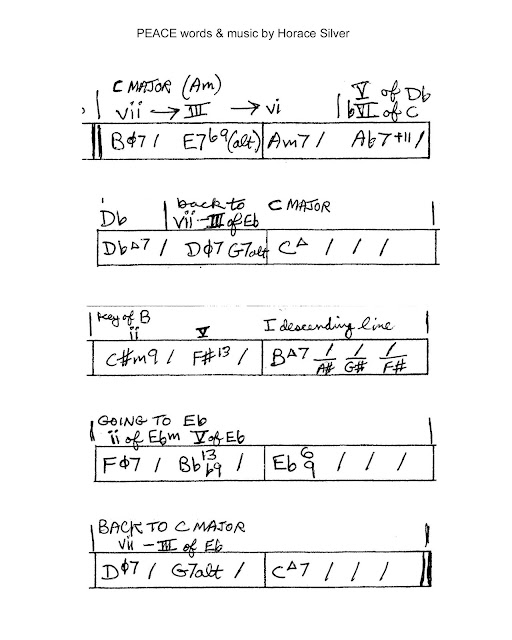This
arrangement has been "stage tested." Unlike the original recording - there are no pedal tones! The bass progression and
chord inversions are the result of careful consideration. A little
rehearsal and the intention of the arrangement will become clear. Discussion is in the key of Ab. Block chart references Roman numerals - note there many chords on the flat scale degrees, i.e. bIII, bII, bVII, bVI. Whether they are dominant chords or major, their accompanying scales will have #4 - with the exception of the bIIIs in the bridge - Ionian with 4 as an "avoid note." The bridge could be thought of as a temporary modulation to bIII.
The
last 4 bars of the A section ("cadence") are used as an intro and as a
tag at the end. The first two chords are basically dominant 7b5 (7+11)
chords, the melody is on the 13th. They could be voiced as "slash"
chords: AMaj7+4/B and GMaj7+4/A.
The verse,
letter A, starts with a Bbm7 (ii chord in Ab) that could be voiced as a
Db triad over Bb in the bass - melody on C would be the 9th of a Bbm or
Maj 7 of a Db chord. The second chord, GbMaj7b5, could also be
considered as Ebm69/Gb, a bit of experimentation should yield the best
inversion(s) for this one. Last 4 of the A section was used for the
intro.
The bridge merits some discussion.
First, the harmonic rhythm is sped up. The first 6 bars took 12 measures
to realize in the ballad version. BMaj7 can be voiced as Ebm7/B, the
Bb7 might be realized as a Bb13 (AbMaj7b5/Bb) - whatever "lays" best on
your instrument. Measure 5 of the bridge, E7b5 (Lydian dominant)
supports a high C# (13th of an E7), a DMaj7b5/E would work. The E7b5 is
an accent chord, foreign to the progression, it doesn't, lead to another
chord, so the goal is to "relax" back to the BMaj7 in bar 6.
Measures
7-10 of the bridge are back to the original harmonic rhythm (borrowed
from the ballad version). The Fm7 (melody is on the 9th) inversion is
maintained for two measures while the bass walks up to Bb. Drums (and
other percussion) buoy things up with accents under the Bbsus, two
eighth note pick-ups and long sustain on the Gb13 "surprise" chord.
(EMaj7b5/Gb? Press roll bar 9?) Backing up for a moment: the bass
anticipates the Bb ("an" beat of 4 in meas. 7) and remains on tempo in
bar 8. Bar 9 could be 8 eighth notes on the root - and a ninth eighth
note would mark the downbeat of measure 10. Then the whole orchestra
gives up a grunt ("huh!") on beat two of measure 10. Drum pick-ups
return us to the last A...
Simply repeat A A B A
until solos are done, repeat the melody and continue on to the "Coda"
which consists of a tag (repeat the last 4 two times) - and then there's
a series of 3 plagal resolutions (church style IV - I), and a ritard to
the final I chord. Drums control the ending!





















